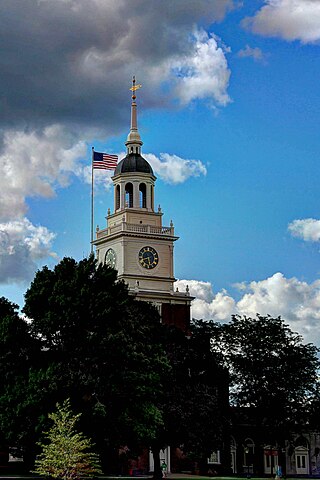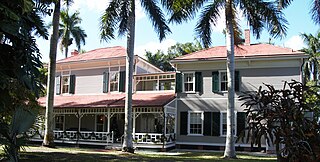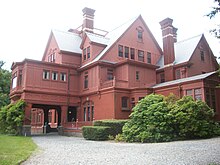
Thomas Alva Edison was an American inventor and businessman. He developed many devices in fields such as electric power generation, mass communication, sound recording, and motion pictures. These inventions, which include the phonograph, the motion picture camera, and early versions of the electric light bulb, have had a widespread impact on the modern industrialized world. He was one of the first inventors to apply the principles of organized science and teamwork to the process of invention, working with many researchers and employees. He established the first industrial research laboratory.

Charles Edison was an American politician. He was the Assistant and then United States Secretary of the Navy, and served as the 42nd governor of New Jersey. Commonly known as "Lord Edison", he was a son of Thomas Edison and Mina Miller Edison.
Menlo Park is an unincorporated community within Edison Township in Middlesex County, in the U.S. state of New Jersey.

Frederick Paul Ott, skilled machinist, was a key employee of Thomas Edison's laboratories from the 1870s until Edison's death in 1931. His likeness appears in two of the earliest surviving motion pictures – the well-known Edison Kinetoscopic Record of a Sneeze and the little-seen Fred Ott Holding a Bird – both from 1894.

Glenmont is an unincorporated community and census-designated place in Montgomery County, Maryland, United States. The United States Census Bureau had combined Glenmont with nearby Wheaton to create the census-designated place of Wheaton-Glenmont, from 2000 to 2010. It had a population of 16,710 in 2020.

The Henry Ford is a history museum complex in the Detroit suburb of Dearborn, Michigan, United States. The museum collection contains the presidential limousine of John F. Kennedy, Abraham Lincoln's chair from Ford's Theatre, Thomas Edison's laboratory, the Wright Brothers' bicycle shop, the Rosa Parks bus, and many other historical exhibits. It is the largest indoor–outdoor museum complex in the United States and is visited by over 1.7 million people each year. It was listed on the National Register of Historic Places in 1969 as Greenfield Village and Henry Ford Museum and designated a National Historic Landmark in 1981 as "Edison Institute".

University Heights is a neighborhood in Newark in Essex County, in the U.S. state of New Jersey. It is so named because of the four academic institutions located within its boundaries: Rutgers University, New Jersey Institute of Technology (NJIT), New Jersey Medical School (Rutgers) and Essex County College. In total, the schools enroll approximately 30,000 degree-seeking students.

The Black Maria was Thomas Edison's film production studio in West Orange, New Jersey. It was the world's first film studio.

The Thomas Edison Center at Menlo Park, also known as the Menlo Park Museum / Edison Memorial Tower, is a memorial to inventor and businessman Thomas Alva Edison, located in the Menlo Park area of Edison, Middlesex County, New Jersey. The tower was dedicated on February 11, 1938, on what would have been the inventor's 91st birthday.

The Edison Museum, a science and history museum about the life and inventions of Thomas Edison, is located in Beaumont, Texas, United States at 350 Pine St. on the grounds of Edison Plaza.

The Edison and Ford Winter Estates contain a historical museum and 21 acre botanical garden on the adjacent sites of the winter homes of Thomas Edison and Henry Ford beside the Caloosahatchee River in Southwestern Florida. It is located at 2350 McGregor Boulevard, Fort Myers, Florida.

Llewellyn Park is a historic gated community and census-designated place (CDP) located within West Orange in Essex County, in the U.S. state of New Jersey. Llewellyn Park is thought to be the country's first planned residential community, and the site of the first large-scale naturalization of crocus, narcissus, and jonquils. The community features 175 homes on 425 acres (172 ha) and is located 12 miles (19 km) west of New York City.
Theodore Miller Edison was an American businessman, inventor, and environmentalist. He was the fourth son and youngest child of inventor Thomas Edison, and founder of Calibron Industries, Inc. He was the third child of Edison with his second wife, Mina Miller Edison.

The Edward G. Acheson House is a historic house at 908 West Main St. in Monongahela, Washington County, Pennsylvania, United States. Probably built about 1870, it is notable as the home of Edward G. Acheson (1856-1931), the inventor of carborundum, and as the likely site of its invention. It was designated a National Historic Landmark in 1976.

The Edison State Park is located in the Menlo Park section of Edison, New Jersey. It is located on Christie Street, the first street in the world to be lit up by lightbulb, just off Lincoln Highway, near the Metropark Train Station. It covers a total area of 37 acres (0.15 km2). The park commemorates the site where the famous inventor Thomas Alva Edison had his Menlo Park laboratory. In his laboratory, Edison invented over 600 inventions such as the incandescent electric light and the phonograph, the latter being the first object to record and play sound.

Pottier & Stymus was a prominent American furniture and design firm of the Victorian period.
Edison laboratory or laboratories refers to one of American inventor and businessman Thomas Edison's labs:

Mina Miller Edison was an American community activist and the second wife of inventor and industrialist Thomas Edison. She was a community activist in Fort Myers, Florida, known for her work advancing the use of public spaces and education initiatives.


















